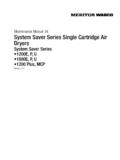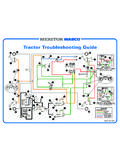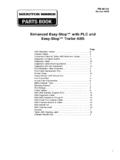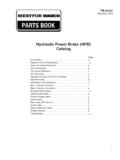Transcription of Maintenance Manual MM-0401 Meritor WABCO …
1 Maintenance Manual MM-0401 Meritor WABCO hydraulic power brake (HPB) SystemRevised 01-17 Service NotesInformation contained in this publication was in effect at the time the publication was approved for printing and is subject to change without notice or liability. Meritor WABCO reserves the right to revise the information presented or to discontinue the production of parts described at any WABCO Maintenance Manual MM-0401 (Revised 01-17)About This ManualThis Manual contains Maintenance procedures for Meritor WABCO s hydraulic power brake (HPB) system for trucks, tractors and You and understand all instructions and procedures before you begin to service and observe all Warning and Caution hazard alert messages in this publication.
2 They provide information that can help prevent serious personal injury, damage to components, or your company s Maintenance and service, installation, and diagnostics special tools when required to help avoid serious personal injury and damage to Alert Messages and Torque SymbolsWARNINGA Warning alerts you to an instruction or procedure that you must follow exactly to avoid serious personal injury and damage to Caution alerts you to an instruction or procedure that you must follow exactly to avoid damage to components.@ This symbol alerts you to tighten fasteners to a specified torque to Obtain Additional Maintenance , Service and Product InformationPublicationsRefer to the following publications for more information on servicing Meritor WABCO s hydraulic power brake (HPB) systems.
3 Maintenance Manual 38, hydraulic ABS for Medium-Duty Trucks, Buses and Motor Home Chassis (C Version hydraulic ABS) Maintenance Manual 39, hydraulic ABS for Medium-Duty Trucks, Buses and Motor Home Chassis (D Version hydraulic ABS) Maintenance Manual MM-0677, hydraulic Anti-Lock Braking Systems (HABS) for Medium-Duty Trucks, Buses and Motor Home Chassis (E Version hydraulic ABS)Visit Literature on Demand on to access and order additional information. Contact the Meritor OnTrac Customer Call Center at 866-668-7332 (United States and Canada); 001-800-889-1834 (Mexico).
4 Or email Tools and Supplies are Specified in This ManualCall Meritor s Commercial Vehicle Aftermarket at 888-725-9355 to obtain Meritor tools and and Non-Asbestos Fibers1 Section 1: IntroductionOverviewSystem Components3 How the HPB System Works5 Section 2: Wiring DiagramHPB Wiring Diagram for Multiplex Vehicles6 HPB Connector Diagram for Multiplex Vehicles7 HPB Wiring Diagram for Non-Multiplexed Vehicles8 HPB Connector Diagram for Non-Multiplexed Vehicles9 Section 3: Troubleshooting and TestingTesting the SystemMeritor WABCO TOOLBOX SoftwareConnecting TOOLBOX Software10 hydraulic power brake Menus and Toolbars14 Standard TestingTest Equipment: Volt-Ohm Meter (VOM)System Requirements and Component TestsTire Size RangeChecking power , Ground and Load Test15 Standard Component TestingIndicator LampsSensor AdjustmentVehicle Test Drive16 Safety FeaturesTowing Procedure for Navistar CE Buses17 Warning Lamps18 SPN, SID, FMI Diagnostic Trouble Code List52 Section 4.
5 Removal and InstallationRemovalHydraulic Compact Unit55 InstallationHydraulic Compact Unit56 RemovalHCU Reservoir57 InstallationHCU Reservoir58 RemovalHCU Accumulators60 InstallationHCU Accumulators62 RemovalElectronic Control Unit (ECU)64 InstallationElectronic Control Unit (ECU)65 Parameter Downloading68 RemovalHydraulic Compact Unit (HCU) Relay Valve69 InstallationHydraulic Compact Unit (HCU) Relay Valve70 RemovalHydraulic Compact Unit (HCU) Pump71 InstallationHydraulic Compact Unit (HCU) Pump72 RemovalMaster Cylinder Replacement InformationMaster Cylinder75 InstallationMaster Cylinder77 RemovalMaster Cylinder Reservoir79 InstallationMaster Cylinder Reservoir81 RemovalMaster Cylinder Foot brake Switch82 InstallationMaster Cylinder Foot brake SwitchRemovalMaster Cylinder Fluid Level Sensor SwitchInstallationMaster Cylinder Fluid Level Sensor83 RemovalParking brake Pressure Supply Valve85 InstallationParking brake Pressure Supply Valve87 RemovalLow Pressure Hose88 InstallationLow Pressure Hose89 LubricationWheel Speed
6 Sensor Specification90 RemovalFront Axle Wheel Speed SensorInstallationFront Axle Wheel Speed Sensor91 RemovalRear Axle Wheel Speed SensorInstallationRear Axle Wheel Speed Sensor92 Section 5: brake Bleeding Procedures93 brake Bleeding ProceduresPressure Bleed ProceduresMaster Cylinder Caliper Circuit97 Spring-Applied/ hydraulic Release Parking brake Circuit98 Changing hydraulic brake Fluid99 brake Fluid Replacement RequirementFilling the hydraulic power brake (HPB) Master Cylinder Reservoir101 Section 6: AppendixLeak Check Procedure for Meritor WABCO HPB SystemCheck the HPB System for brake Fluid LeaksSystem TestAsbestos and Non-Asbestos FibersiMeritor WABCO Maintenance Manual MM-0401 (Revised 01-17) ASBESTOS FIBERS WARNING The following procedures for servicing brakes are recommended to reduce exposure to asbestos fiber dust, a cancer and lung disease hazard.
7 Material Safety Data Sheets are available from Meritor . Hazard SummaryBecause some brake linings contain asbestos, workers who service brakes must understand the potential hazards of asbestos and precautions for reducing risks. Exposure to airborne asbestos dust can cause serious and possibly fatal diseases, including asbestosis (a chronic lung disease) and cancer, principally lung cancer and mesothelioma (a cancer of the lining of the chest or abdominal cavities). Some studies show that the risk of lung cancer among persons who smoke and who are exposed to asbestos is much greater than the risk for non-smokers.
8 Symptoms of these diseases may not become apparent for 15, 20 or more years after the first exposure to , workers must use caution to avoid creating and breathing dust when servicing brakes. Specific recommended work practices for reducing exposure to asbestos dust follow. Consult your employer for more Work Practices1. Separate Work Areas. Whenever feasible, service brakes in a separate area away from other operations to reduce risks to unprotected persons. OSHA has set a maximum allowable level of exposure for asbestos of f/cc as an 8-hour time-weighted average and f/cc averaged over a 30-minute period.
9 Scientists disagree, however, to what extent adherence to the maximum allowable exposure levels will eliminate the risk of disease that can result from inhaling asbestos dust. OSHA requires that the following sign be posted at the entrance to areas where exposures exceed either of the maximum allowable levels:DANGER: ASBESTOSCANCER AND LUNG DISEASE HAZARDAUTHORIZED PERSONNEL ONLYRESPIRATORS AND PROTECTIVE CLOTHINGARE REQUIRED IN THIS AREA. 2. Respiratory Protection. Wear a respirator equipped with a high-efficiency (HEPA) filter approved by NIOSH or MSHA for use with asbestos at all times when servicing brakes, beginning with the removal of the Procedures for Servicing Enclose the brake assembly within a negative pressure enclosure.
10 The enclosure should be equipped with a HEPA vacuum and worker arm sleeves. With the enclosure in place, use the HEPA vacuum to loosen and vacuum residue from the brake As an alternative procedure, use a catch basin with water and a biodegradable, non-phosphate, water-based detergent to wash the brake drum or rotor and other brake parts. The solution should be applied with low pressure to prevent dust from becoming airborne. Allow the solution to flow between the brake drum and the brake support or the brake rotor and caliper.









